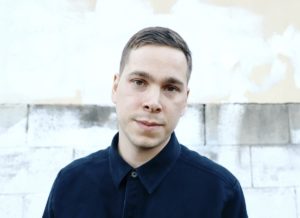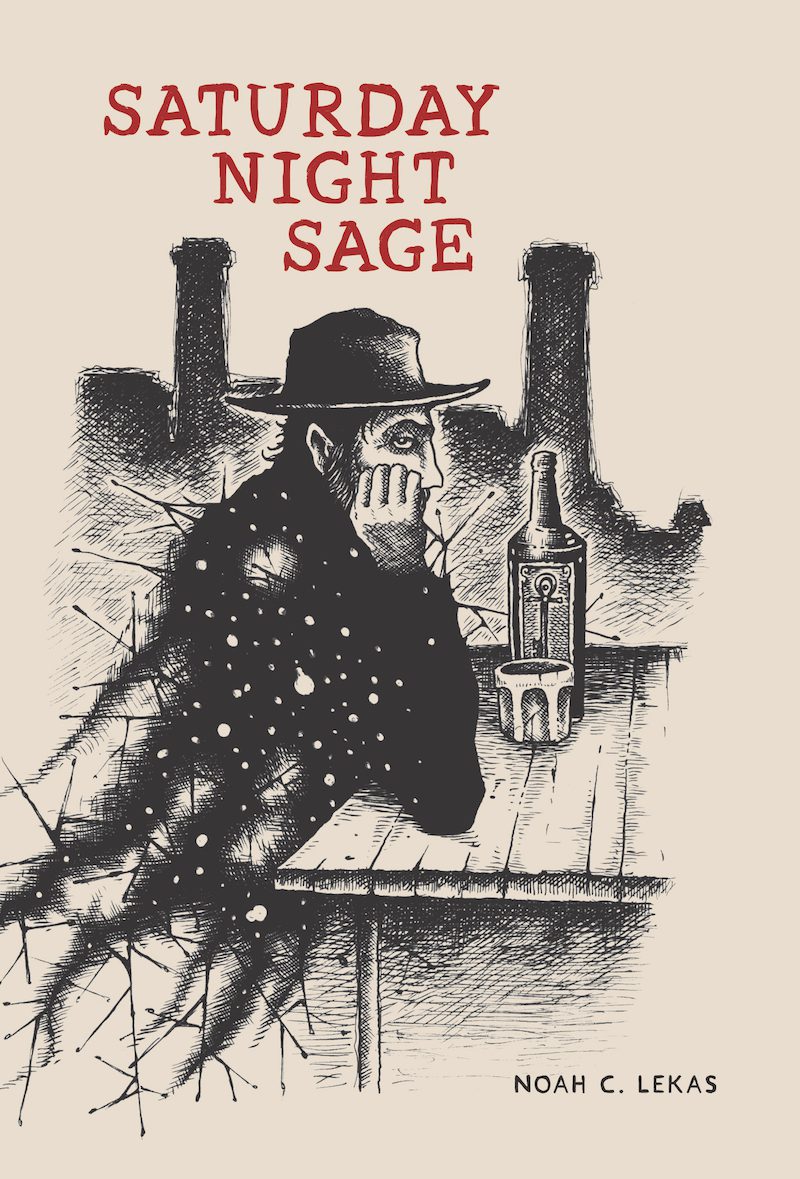
Saturday Night Sage is the first full-length collection of poetry by Noah C. Lekas, and indie record label Blind Owl‘s first literary release. The collection is compromised of forty-two poems examining mysticism and menial labor in modern America; it’s been called a “punk séance for the Beat spirit.” Following a forlorn factory worker who leaves their job in search of god, Saturday Night Sage addresses preconceived notions about what it means to be “beat.”
Raised in a working-class immigrant household in a southeastern Wisconsin factory town, Lekas learned of the mystic almost as early as the menial. Surrounded by Catholics, Buddhists, Hare Krishnas, Pentecostals, and hippies, Lekas’s introduction to the sage’s life of seeking was early and in-depth. His exposure to the immigrant experience, Eastern philosophy, Western religion, universal spirituality, and blue-collar ethos became the inspiration for the sage character of Saturday Night Sage. Though the collection isn’t autobiographical, it’s not a stretch to see where Lekas’s former roles as a factory worker, touring musician, church leader, and truck driver have informed this distinctly Midwestern, blue-collar collection.
The first piece of Lekas’s writing I read was an interview with a mutual friend for No Depression. Lekas’s initial question (“The new record really explores intentionally creating space to unintentionally disappoint people. There is an almost nihilistic celebration of the misfit. How much of that reflects the group’s feelings of unacceptance?”) blew me away; it was the type of question I always want to see in music interviews and rarely do. Since then, we’ve had a digital correspondence about writing and literature.
Given our online friendship, it was fitting we convened digitally during COVID-19 stay-at-home orders to discuss his one-year-old poetry book and the reclamation of Beat DIY spirituality.
***
The Rumpus: So, how’s it going? Self-isolating and quarantining in San Diego?
Noah C. Lekas: It’s going okay. It’s pretty easy here. I’m just glad I’m not still in Brooklyn. All my friends there are saying it’s pretty bad. It’s really disheartening. The last story I read, it’s like, “Okay, it’s halting a bit.” But is that true? It’s really hard to be discerning—this is a whole tangent, but there is so much information and everything is marketing.
Rumpus: This actually leads into the first question I have for you—because you’re absolutely right. At the end of the day, publishing is a business and these different publications have to cater to their audiences. Saturday Night Sage is very much rooted in the Beat literary tradition, and the audience for the Beats these days seems to be the “lit bros” who’re attracted to the drugs and philandering. But that’s not what originally attracted you to the Beats, right?
Lekas: It wasn’t until I was in college that I started hearing anything negative like that. I didn’t have friends that were into literature and I didn’t have a computer in my house until I was almost in college.
But one of the first Beat poems that I ever heard was called “In the Funk World” by Amiri Baraka. My entry point into the Beat world was music. I didn’t even read On the Road until I was in college, which is probably bad to admit, but it just wasn’t the Kerouac that I found. I found “Mexico City Blues” Kerouac. There’s one that’s called The Scripture of the Golden Eternity. And that was amazing to me. It’s complete abstraction—him trying to put the spiritual experiences he was having into some sort of poetry.
Everything’s about how it’s framed, right? If you read On the Road, and that’s your first Kerouac, that’s a very specific, well-branded Kerouac. That’s one way in. The first time I saw a Basquiat piece in person was at work when I had to hang one up. I learned about Basquiat in a class, so my first look at his work was framed in this contemporary narrative of what he means to people now—or should mean. But that’s not the piece, the piece is the piece. Framing changes everything.
The Beats, for me, weren’t packaged up. Somebody compared Saturday Night Sage to Bukowski and… I mean, Hot Water Music affected me as a teenager but my point is, you can’t really control how people see your work. You can only try to explain what your intent for the work is and hope they have a pure experience with it.
Rumpus: I guess Bukowski technically covers the same things—working class, blue collar, etc.
Lekas: There’s no salvation in Bukowski. That’s the difference. There’s an aesthetic similarity, but I see the book like the stuff that I read that I wanted to help put more of in the world. Stuff like Zen and the Art of Motorcycle Maintenance.
Rumpus: That brings up another place your poetry overlaps with the Beats, class difference. Being working class doesn’t mean you don’t appreciate these $200,000 paintings rich people have you bring through the back in “Commuter Train.”
Lekas: It’s my opinion that you probably appreciate them more. When I moved to California, I ended up getting some work writing on staff at an ad agency, which I don’t do anymore, but I remember being told flat out that people from the Midwest were too stupid and they weren’t going to get this particular campaign idea.
And I just remember sitting there in a room being like, “But I am those people. That’s where I’m from. I grew up with every single thing that you’re describing right now.” And then I remember somebody telling me, “Yeah, but you’re different. You got out.” And I said, “No, I’m actually not different; my friends and family members all have the same conversations.”
The divide in perception is part of the struggle of the character in “Commuter Train.” He’s really trying to figure out why what he likes, why what he’s doing, and why his life is sort of in this box and relegated to certain experiences. I think that’s something that I’ve experienced.
It has a lot to do with your audience—who you’re aiming at. There’s a lot of decisions being made all the time to aim at customers who have disposable income. It’s hard to sell a $200,000 painting to somebody who makes eighteen grand a year. Clearly there’s a financial interest in inflating value and driving the arts into a certain space where they won’t be leveraged for social change. Historically, when working people make art it tends to have certain kinds of messages.
Now, social media has actually subverted this quite a bit. Art used to be social media, right?
Rumpus: In a way, there’s this “cult of personality” that’s happening with social media reminiscent of what happened with the Beats, where their personal lives became bigger than the work itself.
Lekas: Well, and it killed them. I mean, very few people survive that.
Rumpus: So, what happens before the cult forms, when it’s just a writer and their ideas?
Lekas: That’s where the heart of the seeker lives and that’s the thing that attracted me to all the writing that I’ve been attracted to: the mystic mind and the heart of the seeker. Anybody who’s out searching for that, to me, is intriguing.
To me, the purpose of poetry is mystic: to open up space for the mystic mind to find new connections. Like Kaufman and a lot of Beat poets—they sort of took a DIY approach to spirituality, which is what ultimately resonated with me. Punk rock was DIY, and that’s the age that I grew up in: I can start my own band, throw my own show, and put out my record; I don’t have to wait for permission. Why wouldn’t spirituality be the same? You could just buy all these books, read them, and you can make your own decision on God. That seems pretty practical. A DIY approach to spirituality, to me, was ultimate freedom.
Rumpus: People tend to view the Beats as one conglomerate with the same ideas and viewpoints—no one even talks about the Beat women, like Diane di Prima or Helen Adams, whose poetry was very musical and very class-oriented. They were writers who dabbled in music, but you’re a writer and a musician. Since the publication of Saturday Night Sage, you’ve collaborated with a lot of musicians and artists to create a multimodal experience.
Lekas: I was trying to be very practical at first. I had this staff writing job and I was listening to a lot of poetry, Burroughs’s albums and John Sinclair with Eddie Kramer, and listening to a lot of lectures on YouTube while I was working. I had a small kid at home and a full-time job—if I read two hours a week, it was a good week. It kind of hit me one day, I’m consuming more writing through video than I am through reading.
One of the great benefits of putting out a book with a record label is the access. I brought it up to Dan Cervantes, the head of Blind Owl, and he was super into it. The first batch I did with Ben Ambrosini, of Taken By Canadians, and Chad Lee, of The Silent Comedy, but I really didn’t have much input. It was really about them reacting to a piece of writing.
Then we sent those three tracks to some filmmakers, and I had nothing to do with that. Jeremiah Zimmerman and Josh Zimmerman of The Silent Comedy did the videos for “Empty Your Pockets” and “Steamroll the Sky.” Scott Rosenbaum did “Out of the Storm Drains“ and the band Mrs. Henry did the music on that one.
Rebecca Joelson did a film for “Midwestern“ that premiered at the Milwaukee Short Film Festival. We also have a video for “We Have a Problem with Groundwater” that was done by Shelby Baldock.
So that’s kind of what’s cool. It’s sort of letting other people do something with it. And I think that’s been super rewarding and really a great learning experience. Because it makes the writing more precious and it makes it less precious all at the same time.
Rumpus: It’s a nice bridge, this back-and-forth conversation with music. So, tell me about the cover art and Alan Forbes—more multimodality.
Lekas: I actually almost didn’t call the book Saturday Night Sage. And then Alan Forbes did the cover art, and he sent it to me, and I was like, “Oh my God, that’s it.” He’s a sagely figure, Alan Forbes. I met him through Dan (of Blind Owl).
Rumpus: Okay, last one: what would you say is the perspective or takeaway readers should have from Saturday Night Sage?
Lekas: Ultimately, it’s about accepting the tension and inevitable release of spiritual life. If you read it, I’d say breathe into it and be in that moment—no parameters, just a mystical openness. Any thought is valid; since it was a contemplative practice to write the book, the goal is to inspire more contemplative practices for people reading it. Hopefully, the takeaway is the journey.
***
Photograph of Noah Lekas by Elizabeth Lekas. Book cover artwork by Alan Forbes. Book design and layout by Elizabeth Lekas.





